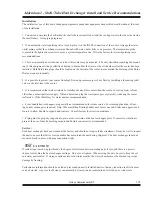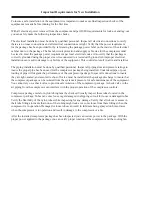
Important Requirements for New Installation
To insure a safe installation of the equipment it is important to make sure final inspection checks of the
equipment are made before running for the first time.
With all electrical power removed from the equipment and per OSHA requirements for lock-out and tag-out
you can safely make the following inspection checks.
The electrical installation must be done by qualified personnel. Inspect all electrical connections to verify
there are no loose connections and all electrical connections are tight. Verify that the power requirement
for the package has been provided for by referencing the package power label on the inside of the electrical
cabinet door on the package. The branch circuit protection and supply cable size for the compressor must
be sized to meet the package power requirement per local electrical codes. Also verify that the package is
correctly grounded using the proper size wire connected to a tested earth ground. An improper electrical
installation can result in damage to or failure of the equipment. This could also result in a fire and fatalities.
The piping installation must be done by qualified personnel. Inspect all piping sizes and pressure ratings to
insure the proper pipe has been used for the compressor package being installed. Undersized pipe or poor
routing of pipe will degrade the performance of the compressor package. Inspect all connections to insure
they are tight, sealed, and secured. A shut-off valve must be installed at the package discharge to insure that
the compressor package can be isolated from the system air pressure for safe maintenance of the equipment.
You cannot rely on a check valve to provide safe isolation of the compressor package. A check valve in the
air piping from the compressor can interfere with the proper operation of the compressor controls.
Compressor package metal or nylon tubing must be checked. Visually inspect these tubes located in the
compressor package. Tubes can come loose or get damaged in shipping so look for loose or damaged tubes.
Verify the flexibility of the nylon tubes while inspecting for any damage. Verify that all tubes are secure in
their tube fittings to insure that none of the tubing might leak at or come loose from there fittings when the
compressor is in operation. Damaged or loose tubes can result in lubricant being sprayed on hot surfaces
when the compressor is in operation and result in damage to the compressor or a fire.
After the installed compressor package has been inspected you can restore power to the package. With the
proper power applied to the package you can verify proper rotation of the compressor and the cooling fan.
Содержание QSI Series
Страница 2: ......
Страница 7: ...Section I General Quincy Compressor QSI 5 MODEL IDENTIFICATION...
Страница 62: ...Section IV Operating Procedures 60 Quincy Compressor QSI 1 Week Timer 2 Remaining Running Time...
Страница 79: ...Section IV Operating Procedures Quincy Compressor QSI 77...
Страница 140: ...Table of Contents Quincy Compressor QSI...


































